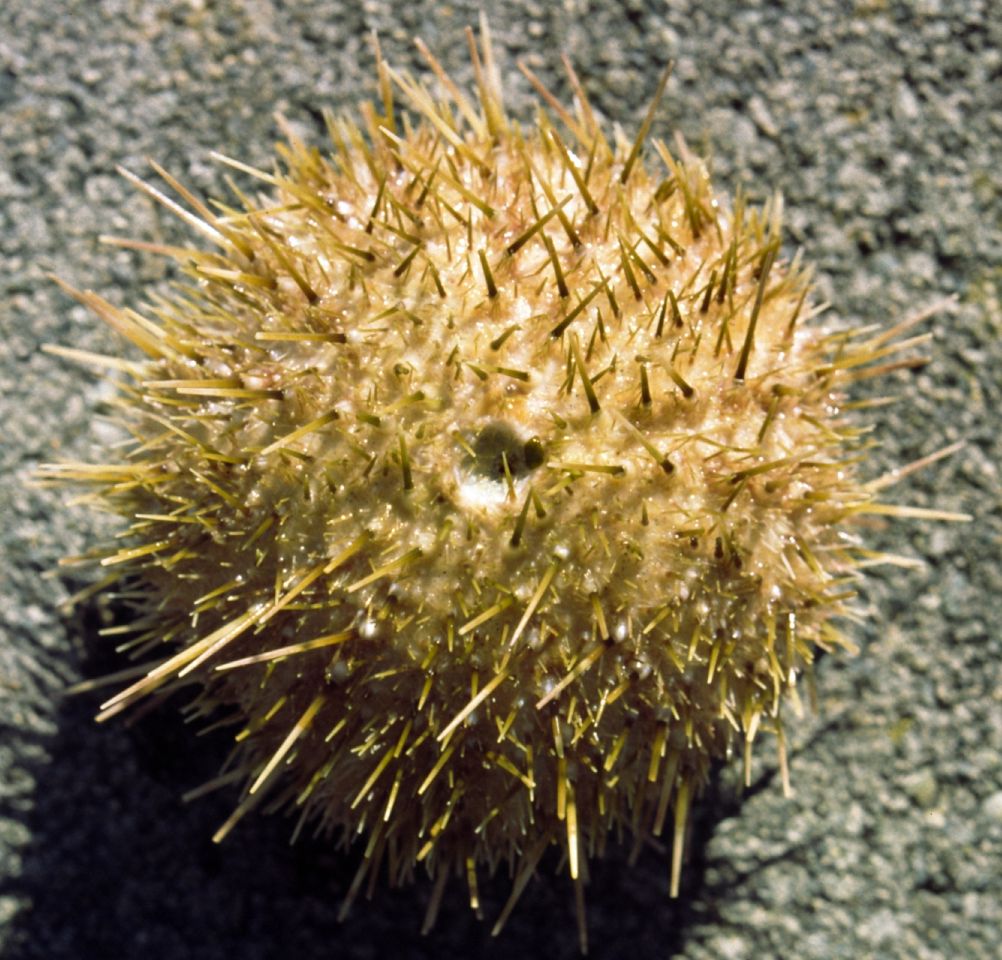Strongylocentrotus pallidus (G.O. Sars, 1871)Common name(s): Pale urchin |
|
| Synonyms: |  |
| Phylum Echinodermata
Class Echinoidea Subclass Euechinoidea Order Echinoida Family Strongylocentrotidae |
|
| Strongylocentrotus pallidus, about 8 cm diameter, captured at 110 m depth in San Juan Channel | |
| (Photo by: Dave Cowles, July 2000) | |
How to Distinguish from Similar Species: S. droebachiensis is similar size and only a slightly darker green hue. However, S. droebachiensis has tube feet darker than the spines, and usually purple. The spines of S. droebachiensis have ridges with rounded surfaces and with periodic, somewhat fan-shaped sculpturings.
Geographical Range: (Occurs at least here and in Norway, off Russia from the Barents Sea down to the central part of the Sea of Japan). Probably pan-Arctic. This and S. droebachiensis are the only species of urchin in the Puget Sound area that are also found in the NW Pacific off Russia (Bazhin, 1998).
Depth Range: Strictly subtidal, and usually deeper than 30 m
Habitat: Known to occur on both sandy/shell hash bottoms and in rocky areas.
Biology/Natural History: Deep-living. May harbor the intestinal rhabdocoel flatworm Syndisyrinx (=Syndesmis) franciscanus. We find this species on sandy/shell hash bottoms in the San Juan Channel at about 100-120 m depth.
According to Strathman (1980), S. pallidus and S. droebachiensis overlap in the Salish Sea in both depth and habitat. In the lab S. droebachiensis eggs can be readily fertilized by S. pallidus sperm but fertilization of S. pallidus eggs by S. droebachiensis sperm is almost totally unsuccessful. Hybrid S. droebachiensis-S. pallidus females resemble S. droebachiensis. They are fertile, and more readily fertilized by S. pallidus than by S. droebachiensis sperm. Male hybrids were not successfully raised to maturity. The two species often compete for kelp in the laboratory. If there is a clear winner in this competition, it is usually S. droebachiensis.
| Return to: | |||
| Main Page | Alphabetic Index | Systematic Index | Glossary |
References:
Dichotomous Keys:Kozloff 1987, 1996
General References:
Lambert
and Austin, 2007
Scientific Articles:
Bazhin, A.G., 1998. The sea urchin genus Strongylocentrotus
in the seas of Russia: Taxonomy and ranges. pp
563-566 in Rich
Mooi and Malcolm Telford (eds), Echinoderms: San Francisco.
Proceedings
of the Ninth International Echinoderm Conference, San Francisco,
California
USA 5-9 August 1996.
McEdward, Larry R. and Benjamin G. Miner, 2006. Estimation and interpretation of egg provisioning in marine invertebrates. Integrative and Comparative Biology 46:3 pp 224-232
Strathman, Richard R., 1980. On hybridization and competition between Strongylocentrotus droebachiensis and Strongylocentrotus pallidus. Page 413 in Michel Jangoux, editor. Echinoderms: Present and Past. Proceedings of the European Colloquium on Echinoderms, Brussels, 3-8 September 1979. 428 pp.
Vilela-Silva AC, Castro MO, Valente AP, Biermann CH, Mourao
PA., 2002.
Sulfated fucans from the egg jellies of the closely related sea urchins
Strongylocentrotus droebachiensis and Strongylocentrotus pallidus
ensure
species-specific fertilization. J Biol Chem. 2002 Jan
4;277(1):379-87
(PubMed)
General Notes and Observations: Locations, abundances, unusual behaviors:

View of S. pallidus underside. Photo by
Dave Cowles, Rosario,
Jul;y 2000
Authors and Editors of Page:
Dave Cowles (2005): Created original page